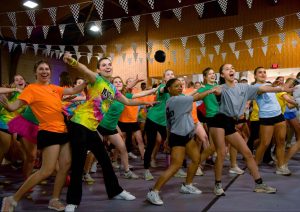Scanning for sustainability
Alumna Meredith Mulhearn (‘01) combines art and technology to plant trees
A Wake Forest alumna hopes to combat deforestation with QR codes.
April 13, 2023
At the intersection of art, technology and environmentalism, artist and Wake Forest alumna Meredith Mulhearn (‘01) combines technology and her passion for the environment in her artwork by using dried moss to create QR codes that combat deforestation with each scan. Mulhearn created two of these 40”x40” QR codes, titled “Reforestation 1” and “Reforestation 2.” In her presentation for Wake Forest’s TechX 2023 on March 28, Mulhearn shared her artistic and technological process of creating these QR codes.
TechX is an annual virtual event held by Wake Forest University Information Systems to showcase the incorporation of technology in the projects and achievements of students, staff and faculty at Wake Forest. TechX 2023 featured Mulhearn as a keynote speaker to discuss her interweaving of art and technology in the spirit of Pro Humanitate.
After graduating from Wake Forest, Mulhearn received her M.A. in art therapy from New York University. As an associate member of Artists for Conservation, the world’s leading artists’ group supporting the environment, Mulhearn combines her passion for environmentalism with her artistic vision.
“We have to take on the role of the caregiver now and sustain the very planet that sustains us,” Mulhearn said. “I do my part through my art by fostering awareness and creating a call to action, and that’s my journey.”
When Mulhearn heard of the opening of RPAC Art Center and Academy in 2018, she jumped at the chance to fulfill her life purpose with art by applying to be the first resident artist. With this newfound opportunity and a background in botanical painting, Mulhearn dedicated her artistry at RPAC to environmentalism.
However, after officially returning to the art scene with RPAC, Mulhearn felt as though something was missing.
“Although I was doing something that I loved, I felt like I had a bigger purpose that I was here for,” Mulhearn said.
Following the path of nature themes and environmentalism to find this missing piece, Mulhearn began to research ideas such as plant blindness — the dark side of technology. Plant blindness is an inability to notice surrounding nature and plants due to the constant use of technology.
According to Mulhearn, plant blindness negatively affects our relationship to the environment and conservation efforts: “The further we disconnect from nature and the less emotional connection we have with nature, the less inspired we feel to support [conservation].”
To combat this negative effect of technology, Mulhearn envisioned a QR code that combined conservation efforts with frequent technology use. The code leads viewers to a donation site to contribute to various non-profit environmental organizations. With or without a donation, Mulhearn tracks each scan and pays for up to 2,000 trees to be planted — one for each scan. According to Mulhearn’s interview with Wake Forest Magazine, a land restoration organization called Trees for the Future automatically plants a tree for each scan that Mulhearn sponsors, up to 2,000 trees at a total cost of $500.
However, without a significant background in technology, this task was not as easy as it seemed.
“There were so many questions that I had to ask before I could even get started,” Mulhearn said.
In order to create a functioning QR code, Mulhearn had to discern proper sizing, positioning and color contrast while combating issues of light sources, positioning and potential shadows that could interfere with the piece.
By a stroke of luck, one of the 15 artists at RPAC happened to be one of the developers of the QR code.

“Kind of amazing to think that of all the little handfuls of people in this entire world that were involved in this process, one of them was in the room next to me,” Mulhearn said.
This vital information allowed Mulhearn to begin the creation process. After days of conducting extensive research, utilizing graphic design programs for mockups, inserting the moss into a sufficient frame, meticulously evening edges and cleaning squares and finding courage after failed attempts, Mulhearn completed her final product.
“I had to be an artist, but I also had to be a designer, an engineer, an architect, a mathematician and a chemist,” Mulhearn said, “and none of this would have been possible without technology.”
One of Mulhearn’s pieces from this series, “Reforestation 2,” is currently on display at the Office of Sustainability in Reynolda Hall. Mulhearn invites students, staff, faculty and others to scan these codes and make a combined effort to preserve the environment
“Scan away! Scan it multiple times,” Mulhearn said. “I encourage you to share it, scan it and plant trees.”
Mulhearn encourages others to use her story as an example to overcome their own limitations and utilize technology to make a difference in the world.
“So my question to you is: how far are you willing to go to make a positive impact? Knowing how valuable technology is, I hope that you all will embrace it and take it to the next level,” Mulhearn said.













